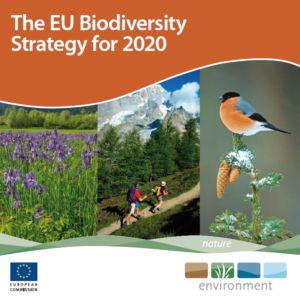EU 2020 Biodiversity Strategy

©EU Commission
In 2011 the EU Biodiversity Strategy was adopted by the European Commission to combat the decline of biodiversity and ecosystem services in the EU by 2020. The strategy is a reference to the commitments made by EU member states within the international Convention on Biological Diversity (CBD) in 2010.
The Strategy – 6 Targets and 20 Actions
- TARGET 1 – Protect species and habitats: By 2020, the assessments of species and habitats protected by EU nature law show better conservation or a secure status for 100 % more habitats and 50 % more species.
- TARGET 2 – Maintain and restore ecosystems: By 2020, ecosystems and their services are maintained and enhanced by establishing green infrastructure and restoring at least 15 % of degraded ecosystems.
- TARGET 3 – Achieve more sustainable agriculture and forestry: By 2020, the conservation of species and habitats depending on or affected by agriculture and forestry, and the provision of their ecosystem services show measurable improvements
- TARGET 4- Make fishing more sustainable and seas healthier: By 2015, fishing is sustainable. By 2020, fish stocks are healthy and European seas healthier. Fishing has no significant adverse impacts on species and ecosystems.
- TARGET 5 – Combat invasive alien species: By 2020, invasive alien species are identified, priority species controlled or eradicated, and pathways managed to prevent new invasive species from disrupting European biodiversity.
- TARGET 6: Help stop the loss of global biodiversity: By 2020, the EU has stepped up its contribution to avert global biodiversity loss.
In 2015, the a mid-term assessment of the EU Biodiversity Strategy 2020 was conducted. The assessment report informs decision-makers of areas where increased efforts are needed to meet the EU biodiversity objectives by 2020 and demonstrates that
action on the ground, supported by adequate financing, can protect and restore nature and the benefits it provides.
The report, voted by an overwhelming majority of MEPs (592 of 689), emphasises the need of “additional, substantial and continuous efforts” to halt biodiversity loss and stresses the importance of the Birds and Habitats Directives to meet the 2020 Biodiversity targets.
The report acknowledges “habitat fragmentation, degradation and destruction” as the most important factors driving biodiversity loss, in a Europe with “around a quarter of wild species at risk of extinction”. It calls on the European Commission and Member States to give higher priority to achieving the 2020 targets and suggests that the EU should remain strongly committed to the Convention on Biological Diversity, ensuring its effective implementation.
The Habitats and Birds Directives, collectively known as Nature Directives, are recognized in the report as a “vital prerequisite for ensuring the success of the strategy“. Therefore, the Parliament calls on the Commission to improve the guidelines and facilitate the implementation of the Nature Directives across Member States.
Nature Directives are currently under a “Fitness Check” process carried out by the European Commission, which led to a massive participation of European citizens and organisations in the consultation process, finished in July 2015.
“After over half million Europeans had raised their voices for nature, I’m really pleased to see the EU Parliament expressing such clear message in favour of Biodiversity and the EU Nature Directives. It is a crucial step towards the successful implementation of the 2020 targets, and a great news for protected areas in Europe”, said Ignace Schops, EUROPARC President, adding, “On behalf of EUROPARC members, I congratulate all MEPs for their commitment to nature. The key words for the future should now be: implementation, enforcement and resources.”
The report opposes a possible revision of the Directives and stresses the need to strengthen their implementation, taking into account economic, social and cultural requirements. Moreover, it calls for an expansion of the available financing tools on biodiversity protection, and a better linkage between the existing funds.
Here you can find an Interactive overview of progress towards all 6 targets and 20 actions as assessed in 2015 by the Biodiversity Information System for Europe (BISE).
7th Environmental Action Programme

©EU Commission
The 7th Environmental Action Programme entered into force in 2014. It functions as the guiding document for EU environmental policies until 2020, while also outlining a vision for the Union’s state by 2050:
A Europe that lives well within our planet’s ecological limits!
In 2050…our prosperity and healthy environment stem from an innovative, circular economy where nothing is wasted and where natural resources are managed sustainably, and biodiversity is protected, valued and restored in ways that enhance our society’s resilience. Our low-carbon growth has long been decoupled from resource use, setting the pace for a safe and sustainable global society. (European Commission)
Three key objectives are designed to guide towards the realization of the 2050 vision, which is just as ambitious as essential:
- to protect, conserve and enhance the Union’s natural capital
- to turn the Union into a resource-efficient, green, and competitive low-carbon economy
- to safeguard the Union’s citizens from environment-related pressures and risks to health and well-being
Eventually, the Action Programme is a commitment by EU, national authorities and stakeholders to speed up the delivery of the objectives of the EU 2020 Biodiversity Strategy.